April 2009 – First Impression
My curiosity (re: obsession/compulsion/enjoyment) got the best of me once again courtesy of my friends from The Kayak Centre in Wickford, Rhode Island, who asked me if I might possibly have any interest whatsoever in the new Epic V12 (Note: slight tongue in cheek reference here). If I did, they could bring one up from South Carolina for me to try. Um…let me think…YES. How could I refuse? That was two weeks ago. Suffice to say it occupied a space in my garage that very evening. I have not put the V12 through all the paces, but here are my initial impressions after paddling it and racing (flat water) it about 10 times, in anywhere from dead flat to 2ft seas.
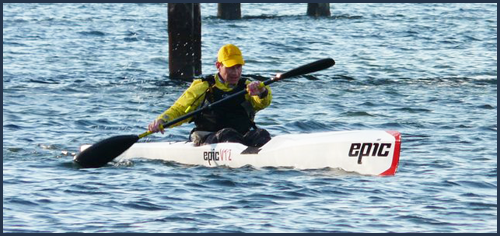 Click to View Wesley’s V12 Photo Gallery
Click to View Wesley’s V12 Photo Gallery
Needless to say, the ski looks highly aggressive, and is an eye catcher with the new Epic graphics and the new chiseled lines. Carrying it to the launch, you can’t help but notice how light it is. I have not weighed it, but it feels lighter than the stated 23lbs. Maybe it felt so because I was elated that I was about to paddle it.
Just prior to sitting in the V12 for the first time, I had it built up in my mind after reading the reviews that the initial stability would be tender. Well after a few strokes, I was pleasantly surprised and immediately thought: ‘Hey, I can paddle this in bigger conditions, not just on flat water as I had anticipated.’ My second thought was: ‘Boy, is this comfortable!’ I am one of many paddlers that likes the fit of the Epic cockpits and the V12 cockpit fit even better. I did later put ¼” of padding in the hip area to have greater contact with the bucket.
After initially paddling the V12 for about 30 minutes in the Wickford Harbor, and just beyond the breakwater in some 1ft chop, I decided that this ski had a lot more utility than I had thought. In other words, the stability was good even for a mid packer like me. The initial stability reminds me of a stable K1, in that it leans from side to side more than my V10Ls. However, if you keep the boat centered with good form, this goes away. Or you just quickly adjust to how this particular ski feels, like you would any other ski. Regarding secondary stability, I again was pleasantly surprised how stable it was. Last week I purposely paddled in 2ft beam and quartering seas and again found myself observing: “This feels really good”.
June 22, 2009 – 9 Weeks Later, 142.42 miles, 23 paddle sessions, 3 Races
Build Quality, Components of the V12:
Now that I have considerable more bucket time in the V12, I am ready to complete my review. Let’s start with the build quality. The hull and deck are flawless with no dimples or unevenness in the layup, smooth and handsome with excellent lines. The footplate and rails are just like the other Epics skis. I did notice however, that after a month, a screw on the foot rail was very loose. I took some marine adhesive and applied that to the screw before I reattached it. No problems after that. Also, when I bought my boat, there was no rudder compartment cap or threads in the rudder compartment to install one. After a day I forgot about the lack of a cover. I do find without the rudder cap, I am more inclined to check the rudder more often. I assume this design flaw was due to my V12 being one of the 1st production models and will be rectified.
The rudder is the larger elliptical type and is very nicely done. The yoke is the standard Epic one that clamps onto the rudder shaft by tightening two allen head screws. The rudder also has a tiny pin in the shaft to keep it from exiting the ski all together, dropping down into ‘Davy Jone’s Locker’. The flat Spectra line is knotted through two holes on the yoke. This is a simple design that has worked for years with the Epic skis, but I must admit it seems it could be modified to ease setup and increase durability in this critical area.
While the larger rudder is necessary for the V12 in the ocean, I mistakenly thought that the V10L rudders would fit the V12. They do not. At the Essex River Race, I had made plans to swap out a smaller V10L rudder prior to the race. Once I quickly figured out they are not interchangeable, I begin fretting about collecting weeds with the elliptical sans kelp guard. My worries were confirmed. Without a kelp guard, I collected the local aquatic flora for the entire race. Lesson learned: If you buy an Epic ski, their weed guards are a must, or you can make you own, but you need a larger weed guard. I now have a kelp guard and have a modified shorter rudder for vegetation-free river racing.
The footplate and foot strap are the standard Epic, along with the frustration of having to untie, readjust, tie, and retie the knotting system in order to adjust the angle of the foot pedals. Once this is done, you rarely have to adjust it again, however, this is one facet of owning Epic skis that is very frustrating. I was also hoping Epic would have replaced the flat Spectra line with a round spectra line that is easier to untie and retie and that stretches much less. The give in the flat, braided line causes a delay in the steering. In other boats that I have owned, the Spectra line has almost no ‘wind up’, making the steering responsiveness almost on a par with skis using stainless steel cable.
You will notice in the foot well area the Epic has included a ruler so you do not have to count the number of holes when adjusting the footplate. Gone are the days of marking the side of your footplate with a piece of tape or pen. All I have to do is remember the number 12, where my footplate has found its home. Simple, but brilliant.
The bailer system drains water out of the footwell in a quick and efficient manner, while letting little water in, even when not at speed. It works superbly. I did place a plastic cable tie around the metal piece to keep it from popping out of the hole on one side when opening and closing the bailer.
While I have experimented with the bailer and the shield, I have chosen to remove the shield and thus leaving the bailer open 99% of the time. Due to my 29.5” inseam, the footplate and pedals moved forward, prevented the shield from attaching until I trimmed about 5 inches off the shield. While the shield does keep a lot of the water from coming over the low gunwales, I found that I was opening and closing the bailer anyway at different points in a paddle or race, so I concluded to just take it off and leave the bailer open. I fixed the shield to the ski, first using tape, and then Velcro; it continued to need adjusting even after I painstakingly spent 2 hours affixing Velcro strips, and paid for a roll of special waterproof tape that eventually failed due to constant soaking. I also found that accessing my hydropack while on my car was difficult with the shield on. Today, in 2ft seas, and 15 knot winds, I only swamped the footwell once while paddling an hour without the shield. With or without the shield, the V12 has the wettest ride of the skis I’ve owned.
Fit:
In my DVD ‘Surfski Basics’, fit is one of the key components I go over in detail. Each ski has its specific handling characteristics which most paddlers can adjust to with time in the bucket. A poor fitting ski, however, can have a major impact on comfort, handling, and overall performance, and is paddler-specific. That said, the V12 is a super comfortable ski. The V10L was comfortable for me and the V12 is an improvement on that. So, if you like the Epic buckets, then you will love the V12 bucket. The back of the bucket is somewhat wider than the V10L. I did add some padding in this area. I found I was a little sloppy in the bucket for my size (175 lb, 33”waist, small to mid hips). As a point of comparison, in the V10L, I needed no padding in this area. The height ratio of the bucket to your feet is excellent, promoting excellent leg drive. The hump of the Epic skis is low and never gets in the way of leg drive, even if you prefer a very low knee height, or if you are on the short side like me. The foot area is typical of the other Epic skis. My size 9 feet fit perfectly with low or mid profile shoes. I am assuming my Mukluks for winter paddling will be fine also, since they worked for my V10Ls.
Stability:
If you have paddled any of the Epic skis, you realize that they have a distinctive twitch that is characteristic. The V12 has slightly more of this twitchiness with regard to initial stability. As you paddle the V12 more, you realize that most of the time the boat is always wobbling, unless in beam or quartering seas. This wobble takes a little time to acclimate to. It is not disconcerting, in that you rarely feel that you are going to capsize due to this motion. Even on flat water, you are aware that the ski is moving around a bit, unless you keep it centered beneath you. Even when not centered, the boat had such a comfortable fit and feel, I was able to relax very early on. The caveat to this is I felt I was using the rudder more to compensate for this motion. (More on that later.)
Where I was pleasantly surprised was that the secondary stability is far better than the V10L. While the overall boat feel is much different than the V10L, the secondary stability is confidence inspiring, at least for me. In small beam to quartering 2-3 ft wind driven waves, the V12 is very solid. That wobble effect disappears and you have excellent secondary stability. In fact, unlike some skis where the secondary stability increases with speed, the V12 is right at home in those conditions at a dead stop. I have often stopped and made adjustments in beam conditions where I would have not felt comfortable in some other skis. Before I get carried away on the secondary stability, my skill level has progressed over the years, so I am more comfortable in the high performance skis than I was a few years ago.
In downwind conditions, the wobble effect is there, but what I notice even more is the tracking of the V12. It is here that I wish the steering was a little more responsive (less play in Spectra line). I must admit I like the foot pedals at more of a laid back angle so that I do not oversteer when pressing on the footplate. This allows your feet to be more relaxed as well, versus constantly taking pressure on and off the opposing foot pedals. Like other skis, once you paddled them regularly, you begin to anticipate their movements in different conditions so that they become instinctual. The V12 is no different in this regard. I found that I must be a little more attentive (anticipatory steering) while going downwind, compared to some other skis.
In upwind conditions, the V12 moves around a bit. It reminds me of another ski that goes over the waves instead of through them. The bow slaps in chorus with the wobble effect, making it a very active ski upwind. Because of the comfort and excellent secondary stability, I never felt like I was going to capsize, but I needed to be more tuned in to the line I wanted to take. I wondered today, if a 32lb.(performance layup) V12 would track better, due to its added weight? I have found this to be the case in all my skis comparing heavier to lighter layups.
Remounting the V12 is fairly easy, comparatively speaking, with the low gunwales and the added width in back of the bucket. As mentioned, I have some padding in the bucket so I don’t slide as smoothly in the bucket as I did my V10Ls, which I found one to be one of the easiest high performance skis to remount. The V12 is not much different.
Speed:
I saved the best for last. I have had 4 PR’s in the V12. The most notable PR was the Sakonnet River Race (12.39 miles) on June 6, 2009. I have done this course 58 times since 2002, when I added it to my favorite courses’ list. The other was on the same course, albeit on a 3.18 mile leg, racing against my paddling partner, Chris Chappell. I averaged a 7.46 minute per mile, which blew away my previous record.
Downwind, the V12 skims over the waves. You feel like a rock skipping over the water. Acceleration is instantaneous with one paddle stroke or two; you can hit the extra gear and feel the increase in speed.
On the flats, the V12 is equally as fast, with or without the bailer opened or closed. As I mentioned earlier, in the bumps and beam seas, you can continue to apply full power due its excellent secondary stability and cockpit comfort.
Summary:
The V12 is a very fun and exciting ski to paddle due to its speed, secondary stability, and cockpit comfort in the conditions that I have paddled in here in Narragansett Bay, Rhode Island, including the Sakonnet River, Beavertail, and Prudence Island. I found it to be noticeably faster than the V10Ls I have owned, and much more stable in conditions. It does have a unique feel to it as I have tried to describe . Quality was excellent, outside of the very minor details I pointed out. Lastly, with all my reviews, this is just my opinion. Your experience may be different from mine depending on skill level and frame of reference in relationship to other skis you have paddled. Please refer to the surfski clarification page for more info on my perspective. ~Wesley
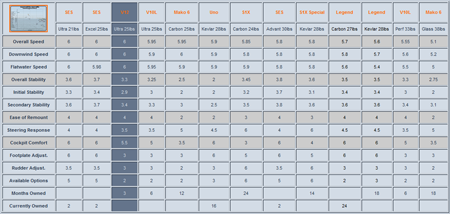
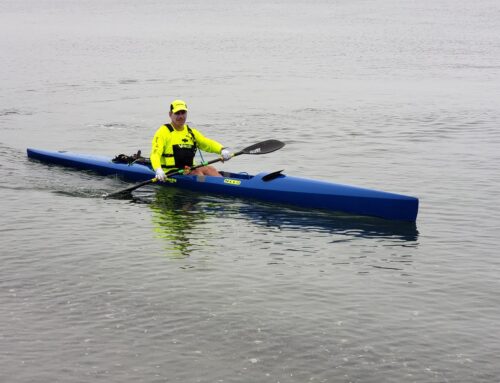
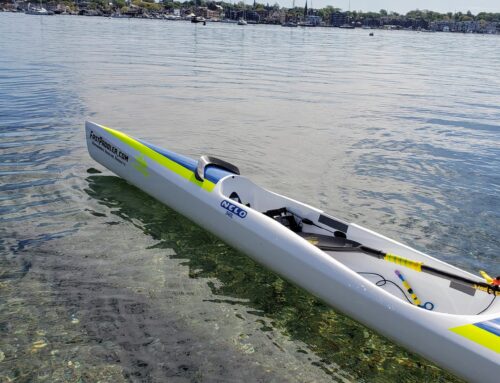
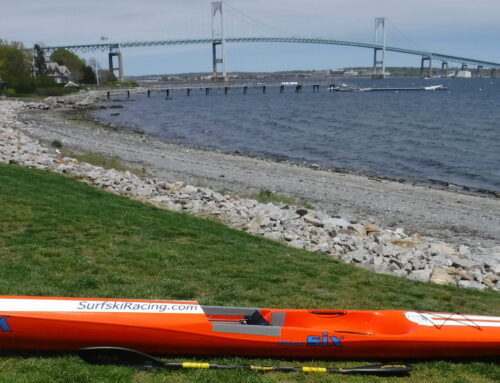
Leave A Comment
You must be logged in to post a comment.